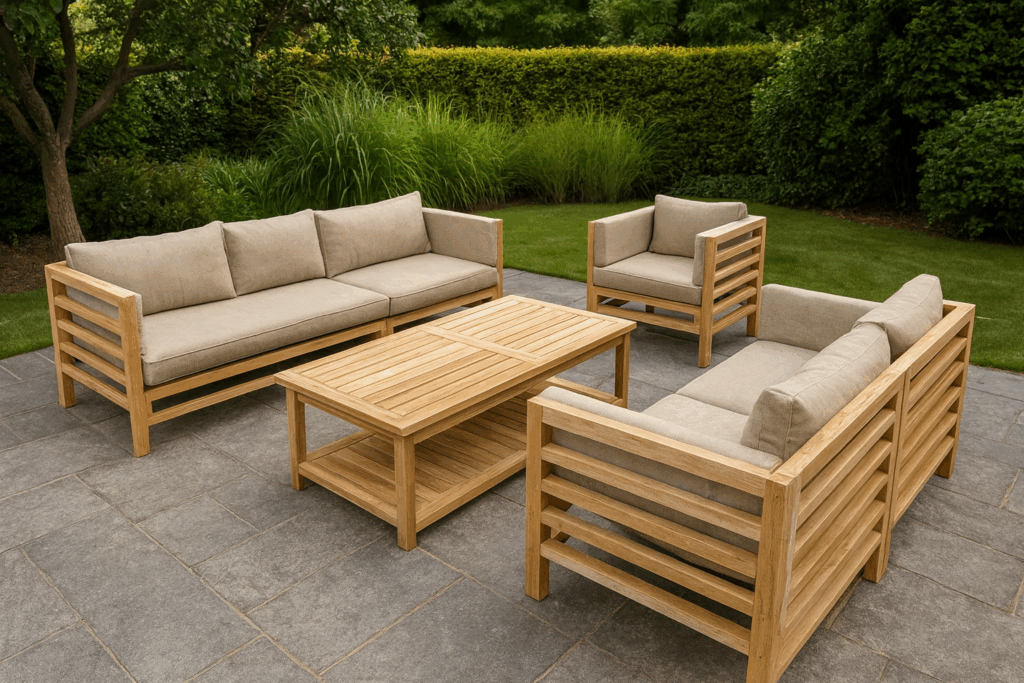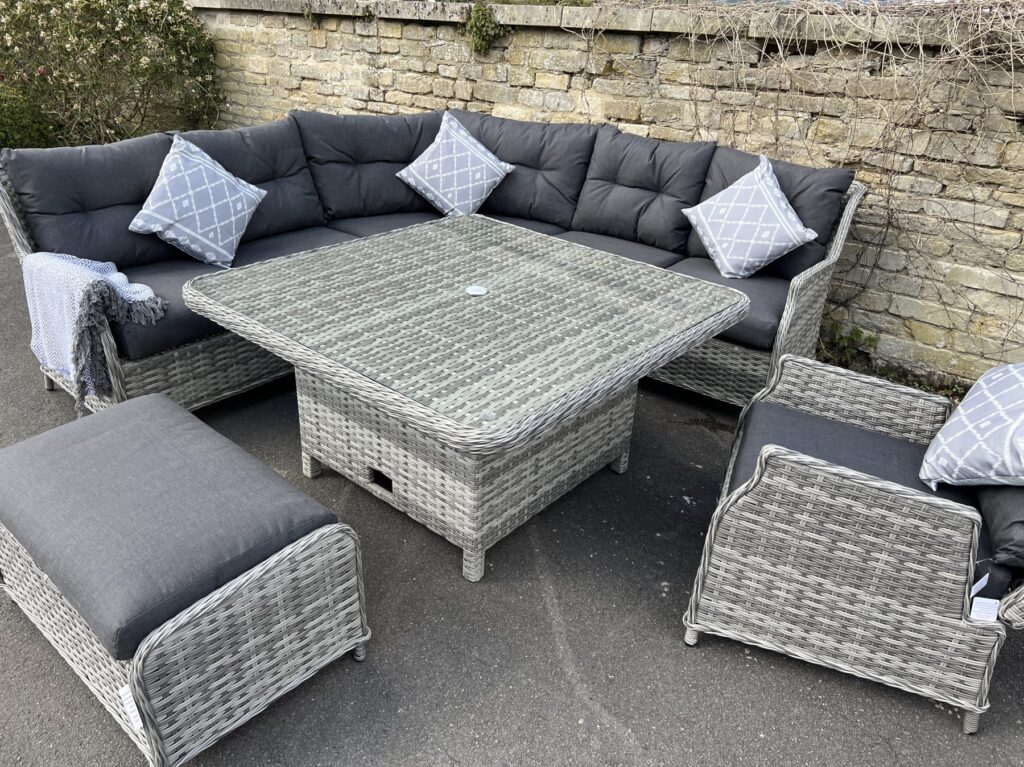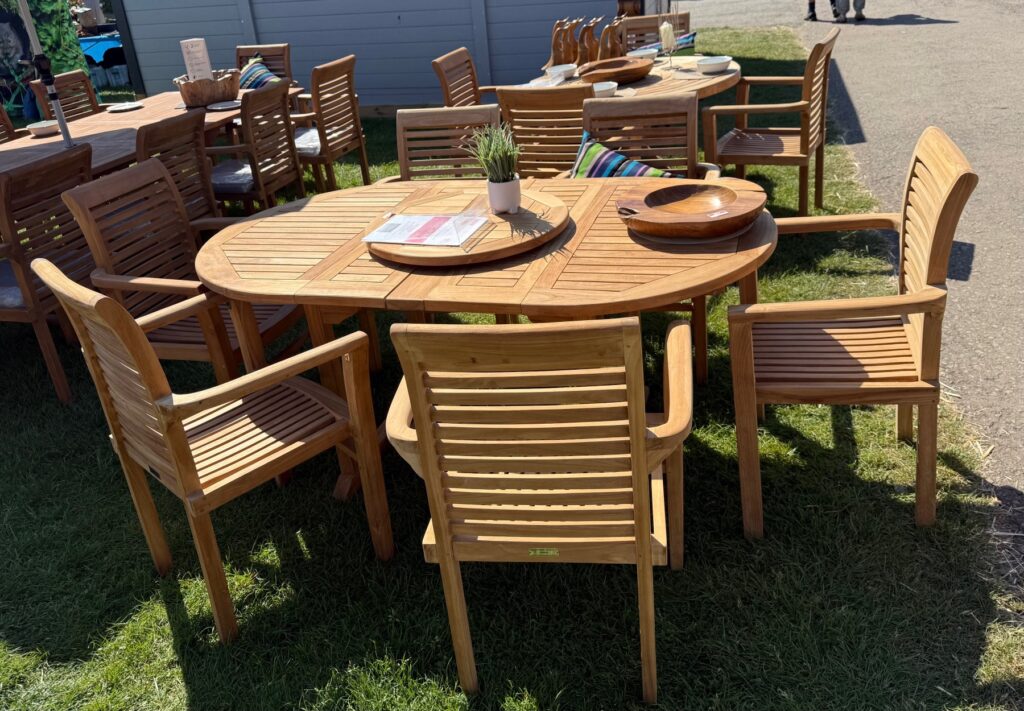Rattan garden furniture, crafted from the outer skin of the rattan vine part of the palm family, represents both tradition and versatility. This material, known for its long, thin stems ideal for weaving, hails from Southeast Asia and boasts a history that stretches back to ancient Egypt. The use of rattan for garden furniture, including patio sets and outdoor dining pieces, combines durability with natural beauty, making it a sought-after choice for enhancing outdoor spaces.
With rattan garden furniture’s increasing popularity, it’s essential to know how to maintain pieces like coffee tables, dining sets, and bistro sets to ensure their longevity. This article will guide you through understanding rattan material, routine cleaning, and the necessary care steps to protect your outdoor furniture against the elements, alongside tips for weatherproofing and restoration. Whether it’s an outdoor table and chairs for cozy backyard gatherings or a full patio furniture set that transforms your outdoor space, maintaining your rattan furniture is key to enjoying it year after year.
Understanding Rattan Material
Rattan garden furniture, celebrated for its durability and aesthetic appeal, is crafted from the outer skin of the rattan vine, a member of the palm family. This material is distinguished by its long, thin stems, which can be either hand-woven or machine-woven using equipment akin to a loom. Originating from Southeast Asia, rattan’s history traces back to ancient Egypt, showcasing its long-standing use in furniture making. For those interested in exploring various rattan furniture options, including outdoor dining sets and patio furniture, a comprehensive selection can be found here.
- Types of Rattan Furniture:
- Natural Rattan: Crafted from the actual vine, it’s suited for indoor or covered areas to avoid direct exposure to elements.
- Synthetic Rattan: Designed to mimic the appearance of natural rattan, it’s weatherproof with a powder-coated aluminum frame to prevent rust and decay, making it ideal for outdoor use.
Rattan’s adaptability and strength are attributed to its growth in tropical jungle settings, with over 600 species that can grow up to 500 feet. Its lightweight, bug-resistant nature, and surprising durability make it a preferred material for crafting furniture that withstands various weather conditions. The process of making rattan furniture involves heating the poles until malleable for shaping, then cooling and drying to harden into the final forms. This method ensures the furniture’s longevity, with natural rattan pieces capable of lasting over 30 years with proper care.
- Maintenance Tips:
- Avoid soaking natural rattan in water to preserve its integrity.
- Synthetic rattan can remain outdoors year-round without weather damage, thanks to its low maintenance nature.
- For both types, regular cleaning and dusting extend the furniture’s life, ensuring it remains a staple in outdoor spaces for years to come.
Rattan furniture, with its unique tortoise-like patterning, not only adds visual depth but also versatility in design, fitting various interior styles from traditional to well-traveled. Its distinction from bamboo or wicker, often misconceived as similar materials, lies in its materiality and weaving technique. Rattan’s enduring popularity, from British Empire homes to Hollywood’s Tropical Deco style, underscores its timeless appeal and functionality as both a durable and stylish choice for garden furniture.
Regular Cleaning and Dusting
To ensure your rattan garden furniture remains in pristine condition, regular cleaning and dusting are essential. Here’s a straightforward guide to keep your pieces looking their best:
Step-by-Step Cleaning Process:
-
Dust Off: Begin by removing loose dust and soil using a handheld vacuum or a brush attachment on your vacuum cleaner. This step prevents dirt from scratching the surface during the cleaning process.
-
Mix Cleaning Solution: Create a gentle cleaning solution by mixing a mild detergent with warm water. For every gallon of water, a few drops of liquid soap are sufficient.
-
Gentle Scrubbing:
- Use a soft cloth or sponge dipped in the soapy solution to gently scrub the surfaces of your furniture.
- For hard-to-reach areas or stubborn stains, an old toothbrush or a soft-bristled brush can be effective.
- Remember to clean between the weaves to maintain the intricate patterns of your rattan.
-
Rinse and Dry:
- Rinse the furniture with a clean, damp cloth to remove any soap residue.
- Ensure the furniture is thoroughly dried to prevent water damage or the growth of mold and mildew. Air drying in a well-ventilated area or under the sun is recommended.
Important Dos and Don’ts:
-
Do:
- Regularly vacuum with a brush attachment to prevent dust build-up.
- Clean spills immediately with a damp cloth to avoid staining.
- Use a solution of hot water and a few drops of liquid soap for a deeper clean.
-
Don’t:
- Use harsh chemicals or abrasive cleaners that can damage the rattan.
- Over-wet natural rattan furniture as it can weaken the fibers.
- Leave the furniture damp; ensure it’s completely dry before use.
By following these simple maintenance tips, your rattan garden furniture will continue to adorn your outdoor space with its natural beauty and charm. For those interested in exploring a wide range of rattan furniture options, from coffee tables to complete dining sets, visit Teak Garden Furniture Outlet.
Ongoing Maintenance and Care
For the ongoing maintenance and care of your rattan garden furniture, a proactive approach can significantly prolong its beauty and functionality. Here are some practical tips to keep your furniture in top condition:
-
Sunlight and Heat Protection:
- Always position your furniture away from direct sunlight and heat sources to prevent discoloration and material damage.
- Consider using UV-resistant covers when the furniture is not in use, especially during peak sun hours. Explore a variety of protective covers here.
-
Moisturizing and Cleaning:
- Periodically apply a thin layer of mineral oil, linseed oil, or a diluted Murphy’s oil soap on the underside of your furniture to keep the rattan moisturized.
- For cleaning, mix warm water with a splash of dish soap. Use a soft cloth for wiping and a soft bristle brush for stubborn dirt. Rinse with cold water and allow to air dry.
-
Seasonal Care and Damage Prevention:
- Spring Check: Inspect for structural damage and signs of mildew. Clean thoroughly with soapy water and dry well.
- Cushion Care: Store fabric elements like cushions in a dry place. If mildew appears, brush off excess dirt and wash with cold water and bleach. Dry completely before use.
- Furniture Movement: Avoid dragging the furniture to prevent fiber damage. Lift by the frame, not the woven parts.
- Mold and Mildew: At the first sign of growth, treat immediately with a solution of bleach and water.
- Weatherproofing: Apply a hardwood garden furniture treatment for extra protection against the elements.
By adhering to these ongoing maintenance and care tips, you ensure that your rattan garden furniture remains a durable and attractive feature of your outdoor living space. Regular attention not only preserves the material but also enhances the enjoyment of your outdoor gatherings.
Weatherproofing Your Furniture
To ensure your rattan garden furniture withstands various weather conditions, implementing weatherproofing measures is crucial. Here are effective strategies:
-
Using Garden Furniture Covers:
- During autumn and winter, safeguard your furniture with high-quality garden furniture covers. These covers protect against rain, snow, and debris, significantly extending the lifespan of your furniture. For a selection of covers designed specifically for rattan furniture, visit Teak Garden Furniture Outlet.
- In spring and summer, when furniture is more frequently used, continue to cover pieces when not in use to shield from sudden rain showers or prolonged sun exposure.
-
Weatherproofing Treatments:
- Apply marine varnish to your rattan furniture to create a protective layer against moisture. This varnish should be applied in a well-ventilated area and allowed sufficient time to dry.
- For natural rattan furniture, a coat of varnish every three years or tung oil twice a year provides an additional layer of protection, maintaining the furniture’s integrity and appearance.
- Consider a hardwood garden furniture treatment for an extra safeguard against the elements. These treatments are designed to penetrate the material, offering long-term protection without compromising the furniture’s natural aesthetic.
-
Care and Storage:
- Ideally, store furniture in a dry indoor location during harsh weather months. If outdoor storage is the only option, ensure furniture is securely covered.
- Cushions and fabric accessories should be stored indoors or in a dry, ventilated space to prevent mold and mildew. Regular washing of these elements keeps them fresh for the next season.
- For added protection from dust, bird droppings, and unpredictable weather, a water-resistant cover is advisable. Not only does it keep the furniture clean, but it also reduces the frequency of deep cleaning required.
Remember, keeping your rattan garden furniture clean is just as important as weatherproofing. Regularly remove surface dirt with a brush or vacuum cleaner, and clean using a mixture of warm water and washing liquid. Rinse thoroughly and allow to dry completely before replacing cushions and accessories. This routine maintenance, combined with strategic weatherproofing, ensures your rattan furniture remains a beautiful and durable addition to your outdoor space.
Repair and Restoration
Repairing and restoring rattan garden furniture can breathe new life into your cherished outdoor pieces. Here’s a structured approach to tackle common issues and restore your furniture’s appearance and durability:
Initial Assessment and Cleaning
- Step 1: Start by cleaning the furniture with a solution like Krud Kutter or Windex for glass to remove grime and prepare the surface. For a wide selection of rattan furniture cleaning solutions, visit Teak Garden Furniture Outlet.
- Step 2: Trim off any broken pieces of rattan using wire cutters or large scissors. This prepares the furniture for further restoration steps.
- Step 3: Gently sand the furniture by hand using 120 grit sandpaper to smooth out rough spots and prepare it for painting or varnishing.
Repairing Damages
- For Missing Cane Strips:
- Use hot glue to secure a folded paper strip or alternative materials like straws, cardboard, or plastic in place of missing cane strips.
- For Broken or Loose Pieces:
- Secure these parts with wood glue, super glue, or a hot glue gun, depending on the severity and location of the damage.
- Use clamps to hold pieces in place as the glue dries, ensuring a firm bond.
Refinishing and Protection
- Painting:
- Apply paint directly to the furniture without priming. Tobacco Brown ONE from Melange Paints is recommended for a natural look.
- For a more durable finish, opt for Rust-Oleum spray paint (2X Ultracover Paint + Primer), providing comprehensive coverage and protection.
- Sealing:
- Finish with two coats of Clear Gloss Polycrylic from Minwax, using a sponge brush or a small paintbrush for a glossy finish. This seals the paint and protects against weathering.
- Alternatively, a clear spray varnish or lacquer can be applied to protect the paint and maintain the furniture’s appearance.
By following these steps, you can effectively repair and restore your rattan garden furniture, ensuring it remains a beautiful and functional part of your outdoor living space for years to come.
Conclusion
Throughout this article, we have explored the timeless appeal and practical maintenance of rattan garden furniture, delving into its historical significance and the essential care needed to preserve its beauty and functionality. We’ve covered a broad range of topics from understanding the material’s unique properties, regular cleaning and dusting techniques, to more specialized tasks like weatherproofing and restoration. Each of these sections serves to equip you with the knowledge to enjoy your outdoor rattan furniture for many years, making it a worthwhile investment for enhancing your garden or patio space.
As we conclude, it’s important to remember that the longevity of rattan furniture lies in the commitment to its care. Embracing the maintenance tips and restoration practices detailed can significantly extend the life and appearance of your pieces. Moreover, the actions we take today to preserve our rattan furniture not only ensure we continue to enjoy its comfort and aesthetic appeal but also uphold a tradition of craftsmanship and sustainability. For those looking to explore further or to find the perfect piece to add to their outdoor collection, a wide array of rattan furniture options can be found at Teak Garden Furniture Outlet, catering to varied tastes and outdoor spaces.
FAQs
How can I properly care for my rattan garden furniture?
To clean your rattan garden furniture, start by using a soft brush to gently remove any surface dirt and dust. Prepare a cleaning solution by mixing mild detergent with water until bubbles form. Then, with a lint-free cloth, use only the bubbles to wipe down the furniture surfaces, avoiding the use of water directly on the rattan.
What are the best practices to keep rattan furniture in good condition?
To prevent rattan from drying out and cracking over time, it’s advisable to treat it with boiled linseed oil annually. Apply the oil generously with a large paintbrush, allowing the rattan to absorb as much as possible. Afterwards, remove any excess oil with a soft cloth.
What steps should I take to extend the life of my rattan furniture?
To ensure your rattan furniture lasts longer, clean the weave with a small brush or toothbrush to remove trapped dirt. Additionally, consider using a winter garden furniture cover for added protection against dirt, dust, and the elements.
Is it necessary to oil rattan furniture, and if so, how?
Yes, rattan furniture benefits from being oiled. Create a mixture by adding a glass of linseed oil to a litre of warm water with a few drops of turpentine. Apply this emulsion to the furniture, let it sit for 15 minutes, and then wipe it off with cold water to finish the treatment.













